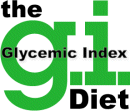GI Diet Plan

The GI Diet Plan is based on the idea that carbohydrates (both simple and complex carbs) hold a Glycaemic Index (GI) value between 0 and 100 and that these values can play a part in weight loss or weight management. The higher the GI value the easier the carbohydrate is ingested by the body and transported into blood stream. The lower the GI value the longer the sugar takes to move into the blood stream.
This also means the higher the Glycaemic Index score the larger the effect on blood sugar levels over short periods of time.
How does the GI Diet Plan work?
The Glycaemic Index runs from 0 to 100 and usually uses glucose - which has a GI value of 100 - as the reference. In simple terms, the GI index tells us whether a food raises blood sugar levels dramatically, moderately or a little bit.
Foods with a low GI value will release sugar into the blood stream slowly and allow the energy to be used at a steady rate. Whereas a food with a GI value will release sugar into the blood stream quickly, procuding readily usable energy while also increasing the level of insulin produced.
This means two things. Firstly, a food with a low GI score will satisfy the appetite for longer and means the dieter is less likely to reach for a sugar snack to feed their hunger. Secondly producing low levels of insulin means that the body is less likely to store the energy from the low food as body fat - something could be a danger when eating a food with a high GI value.
The Glycaemic Index food chart
Below is a table highlighting the Glycaemic Index value category of many popular foods. Use this to create your own GI Diet plan.
|
High GI Diet foods
Values of 70 - 100
|
Medium GI Diet foods
Values of 56 - 69
|
Low GI Diet foods
Value of < 55
|
|
Glucose sports drinks
White bread
French bread
Bagels
Croissants
Muffins
Watermelon
Dates
Figs
Ripe bananas
Highly refined breakfast cereals
Old potatoes
Baked potatoes
Beetroot
Carrot
Parsnips
Cola
|
Honey
Ice cream
New potatoes
Jam
Couscous
Potato chips / crisps
Pineapple
Mango
Kiwifruit
Raisins
Oatmeal cookies
Sweetened condensed milk
Bran muffin
Whole-wheat bread
Pitta bread
Rye crispbread
|
Apples
Apricots
Cherries
Grapefruit
Oranges
Peaches
Pears
Unripe bananas
Most fresh fruit juices.
Asparagus
Broccoli
Celery
Cauliflower
Red cabbage
Sprouts
Green beans
Radish
Peppers
Salad vegetables.
Sweet potato
Pasta
Sweet corn
Peas
Chick peas
Most type of beans
Lentils
Basmati rice
Long grain brown rice
Wild rice
Porridge oats
Muesli
Bran cereal
Peanuts
Peanut butter
Cashew nuts
Chocolate bar
Strawberry jam
Popcorn
Rye bread
Mixed grain bread
Diet cola
|
Advantages of the GI Diet Plan
The GI Diet doesn't ban certain foods, it merely suggests you eat certain foods at certain times. For example, a food with a moderate to low GI score makes a wonderful breakfast as it will release energy and sugar gradually throughout the morning and suppress the appetite until lunch time. Whereas after exercise the body's blood sugar levels will be low and so a food that has a high Glycaemic Index score will allow the exercise to replenish their energy quickly.
Disadvantages of the GI Diet Plan
The main disadvantage of the GI Diet is the fact that although food labels detail calories and nutrients, including the amount of sugar contained in foods, many neglect to outline the Glycaemic Index score. This means that sometimes guess work plays a part in identifying the GI score of foods. However, as you can see in the food table above, many foods that are high in simple sugars are actually identified as having low GI scores.
Also, many foods that fall on the moderate to low category on the GI Diet plan can be calorie packed. This can mean that although the food you are eating has a low Glycaemic Index, if you take on too many calories, you will still not lose weight. In fact eat too many extra calories and you could gain weight using the GI Diet plan!
The GI Diet Plan - Conclusion
Many dieticians and nutritional scientists do believe that the principles of the GI Diet plan ring true. However, they also stress that other factors can alter the part the Glycaemic Index score of food actually plays. It is true that each food does have a GI score. However, eating a mixture of these foods in a meal which also contains protein and fats may alter the GI score of a food that usually scores between 70 and 100 on the GI Diet food plan.
That said, aim to eat low GI foods for breakfast, include a small selection of moderate GI foods for lunch to add as a midday pick me up and eat low GI foods in the evening. If you exercise, eat moderate to high GI foods in the 2 hours after exercise to replenish any loss of blood and muscle sugar levels.
Is the GI Diet Plan the same as the Atkins Diet?
NO. The Atkins Diet suggests that the dieter limits their carbohydrate to nil followed by limited amounts in the rest of the diet. The GI Diet plan suggests that the dieter eats a range of carbohydrates throughout the diet but that they are aware that they should eat certain carbs at certain times of the day.

Latest health and fitness news
 All news stories
All news stories
Latest quizzes and tests
 All quizzes &
tests
All quizzes &
tests
|

